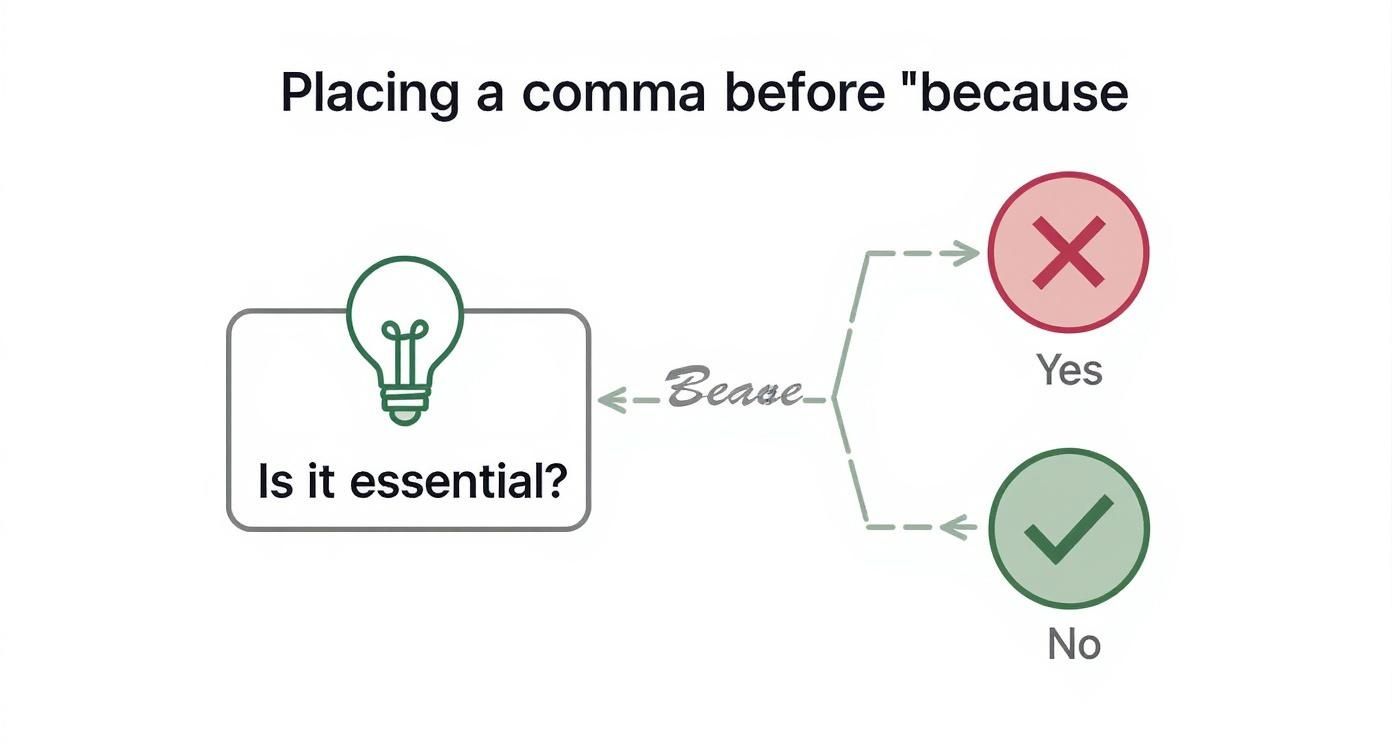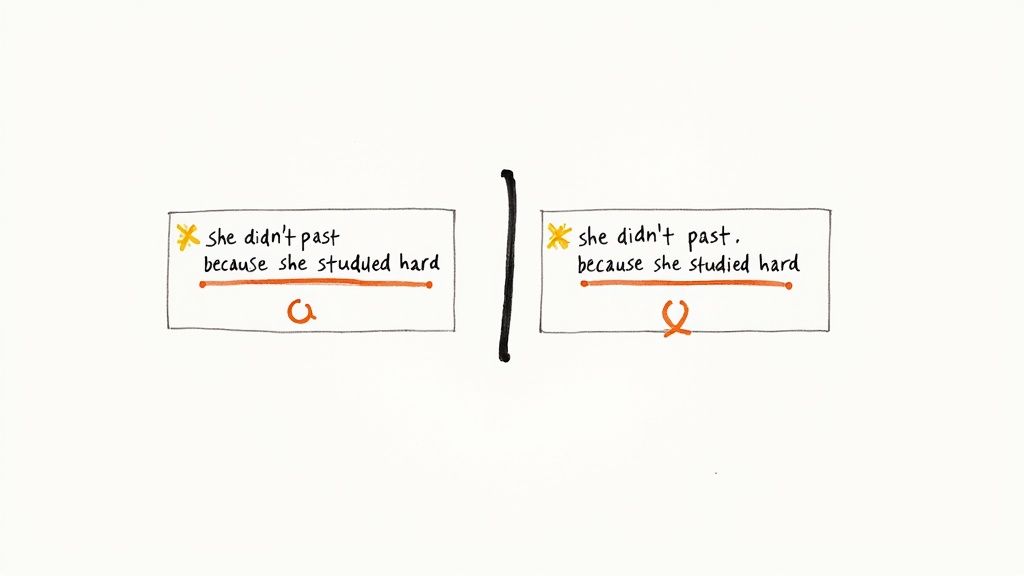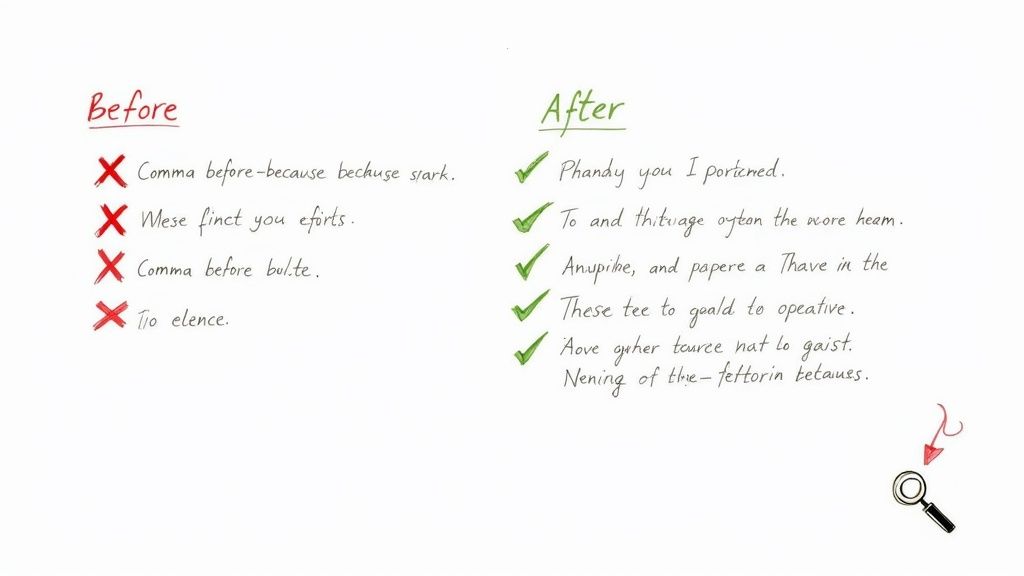
Here's the simple truth: In most cases, you don't need a comma before because. We know that might sound counterintuitive, but it's a fundamental rule that helps keep your writing clear and direct.
Think of it this way: the word "because" usually introduces the core reason for something—information so vital that the sentence would feel incomplete without it. As writers and content creators, we don't use commas to separate essential information from the rest of the sentence.
Understanding the Comma Before Because Rule
The whole "comma before because" debate can feel more complicated than it is. For anyone writing—whether you're a content creator, a student crafting an essay, or a professional sending emails—getting this right is all about making your point clearly.
When you use a "because" clause, you're essentially answering the question "why?" If that answer is crucial to the main point you're trying to make, you should leave the comma out. It's that simple.
Getting the hang of basic punctuation is a cornerstone of effective writing. It’s not just about avoiding errors; it’s about professionalism and clarity, especially when research shows that quality content gets significantly more engagement. If you're looking to brush up, our guide on basic grammar rules is a great place to start.
The Essential Information Test
Here’s a simple test you can apply every single time. Just ask yourself: "If I remove the 'because' part, does the main meaning of my sentence collapse?"
- If the answer is yes, don't use a comma. The information is essential.
- If the answer is no, a comma is probably the right move. The information is just extra context.
Let’s try it with a real-world example: "The event was canceled because it rained." The reason it was canceled—the rain—is the whole point. Without that clause, your reader is left hanging. The core message is gone.
Key Takeaway: When the reason is the main point, a comma just gets in the way. It puts an awkward pause between an action and its direct cause, disrupting the natural flow for your reader.
This little test will steer you right more than 90% of the time. Of course, there are exceptions. We'll get into those next, especially when dealing with negative sentences or complex ideas where a comma actually prevents confusion.
To make this even clearer, here’s a quick-reference table summarizing the core rules.
Comma Before Because A Quick Guide
| Situation | Comma Rule | Example |
|---|---|---|
| The reason is essential to the sentence's meaning. | No Comma | He was tired because he stayed up all night. |
| The "because" clause adds non-essential info. | Use a Comma | He wasn't late for the meeting**, because** it was rescheduled. |
| The sentence is negative and could be ambiguous. | Use a Comma | She didn't win the race**, because** she cheated; she won because she was fastest. |
| The "because" clause is an interruption or afterthought. | Use a Comma | I'm finally going to bed**, because**, frankly, I'm exhausted. |
This table should give you a solid at-a-glance guide for most situations you'll run into.
Essential vs. Nonessential Clauses: Getting to the Heart of the Matter
To really get a handle on the "comma before because" rule, we need to talk about essential and nonessential clauses. It’s less complicated than it sounds. An essential clause is like a key ingredient in a recipe; a nonessential clause is more like a garnish—it adds something extra, but the recipe still works without it.
An essential clause gives information that is absolutely critical to what you're trying to say. If you remove it, the sentence's meaning completely changes. When the "because" part is essential, you don't use a comma.
On the other hand, a nonessential clause just adds extra, "by the way" information. The core of the sentence would be perfectly clear without it. This is your green light to use a comma, as it signals to the reader that what follows is an added thought.
The Litmus Test: Is the Clause Essential?
So, how do you tell the difference in your own writing? The easiest way is to ask yourself one simple question: "If I remove the 'because' clause, does the main point of my sentence completely fall apart?"
Let's put it to the test with some use cases.
Essential Clause Example: The project was delayed because the server crashed.
- Test: Take away the "because" part, and you're left with, "The project was delayed." Okay, but why? The reason is the whole point. The clause is essential, so no comma is needed.
Nonessential Clause Example: He didn't call me, because he had already sent an email.
- Test: The main point is, "He didn't call me." That's a complete thought. The reason why is just extra context. Since the "because" clause is just additional info, you need a comma.
Mastering this check is a huge step in building clear, professional sentences. If you want to dig deeper, our guide on compound and complex sentences is a great next step.
This infographic breaks down the decision-making process into a simple visual.

As you can see, once you know whether the clause is essential, the path forward is pretty clear.
How One Little Comma Changes Everything
It's amazing how much power a single comma can hold. Its presence or absence can completely flip the meaning of a sentence. This is a subtle area where AI writing tools often stumble, missing the human context behind the choice. We believe in using AI ethically, which means treating it as a starting point, not the final word.
A study of a major newspaper found that a comma appeared before 'because' in roughly 13% of instances. This isn't an error rate; it’s a reflection of writers making a deliberate choice to add clarity.
Without a comma, "because" directly explains the why. With a comma, it introduces a separate, explanatory thought. Getting this right is crucial for authentic writing. As a writer, you're guiding your reader's understanding, and a well-placed comma is one of your most effective tools.
When a Comma for Clarity Is Non-Negotiable
While the "no comma" rule is a solid default, there are times when skipping it can completely muddy your meaning. These are moments where a comma is the only thing standing between clarity and confusion. Get it wrong, and you risk your reader completely misunderstanding your point.

This is especially true when you're dealing with negative statements. A missing comma here can create a real head-scratcher—a common blind spot for many AI writing tools that don't grasp semantic nuance. A human writer, however, knows how to use this tiny mark to steer the reader’s understanding with precision.
Clarifying Negative Sentences
The single most critical time to use a comma before because is when you’re explaining a negative statement. Without it, you force your reader to guess what you’re trying to say.
Let’s look at a classic example:
- Without a comma: She didn't pass the exam because she studied hard.
- With a comma: She didn't pass the exam, because she was too sick to focus.
The first sentence is a mess. It could imply that studying hard was the reason she failed, which makes no sense. The second sentence is crystal clear. The main point is simple: she didn't pass. The comma introduces the reason why.
The comma essentially puts up a wall. It signals that the "because" clause is explaining the entire negative idea that came before it. It says, "Stop. Now I'm going to tell you the real reason."
That little punctuation mark removes all doubt. It takes a potentially ambiguous sentence and makes it direct, ensuring your message lands exactly as you intended.
Adding a Breather in Complex Sentences
A comma can also be your best friend in long, complex sentences. When you have several clauses jostling for attention, a well-placed comma gives the reader a much-needed pause to process the information.
Think of it as a helpful signpost on a winding road. In academic writing, for example, you’ll see writers use a comma before 'because' to improve readability. A sentence like, "The committee postponed the meeting, because several key members were unavailable," uses the comma to cleanly separate the decision from the reasoning.
This is especially helpful when a sentence juggles multiple ideas. Without that comma, everything can run together, forcing your reader to reread. If you're looking to master this, check out our guide on examples of compound sentences.
How to Make the Right Call
When you're editing your own writing or humanizing AI-generated text, run through this quick mental checklist to decide if you need that comma:
- Is the main clause negative? If you’ve written "He didn't," or "It's not," adding a comma before the reason is almost always the right move.
- Is the sentence long and complex? If you have multiple ideas, a comma before "because" helps organize the flow for your reader.
- How does it sound? Read the sentence out loud. If you find yourself naturally pausing before "because," that’s a huge clue that a comma belongs there.
How Modern Style Guides See the Rule
Grammar isn't set in stone; it evolves. When it comes to the comma before because, major style guides like AP Style and The Chicago Manual of Style have moved toward a flexible, common-sense approach. The modern consensus is simple: context is everything.
This shift is part of a larger movement away from rigid rules. Instead of forcing writers to memorize unbreakable laws, the new thinking encourages us to use punctuation as a tool—a way to make our meaning impossible to mistake. For content creators and professionals today, this is a much more practical way to think about grammar.
From Inflexible Rules to Reader-First Punctuation
Not too long ago, some of the strictest grammar gatekeepers would have flagged almost any comma before "because" as an error. That perspective is now largely outdated. You can dive deeper into how punctuation standards change in our guide on capitalization and punctuation.
The big idea now is that punctuation's primary job is to serve the reader. So, while the default is still "no comma" when the "because" clause is essential, style guides now openly recommend adding one whenever it helps prevent confusion.
The Modern Takeaway: Clarity beats dogma. If a comma makes your sentence clearer—particularly in a negative or complex sentence—today’s style guides will have your back. They see punctuation as a means to an end, not just a list of arbitrary rules.
A Peek at What the Top Style Guides Say
While all the major guides are leaning into flexibility, they each have their own slightly different take. Knowing these small differences can help you make the right call for whatever you're working on.
The Chicago Manual of Style (CMOS): The bible for book publishing, CMOS advises using a comma before because anytime it's needed to prevent a misreading, especially with negative statements.
AP Style: The Associated Press Stylebook is all about concise communication for journalists. It generally steers you away from the comma unless the "because" clause is nonessential.
MLA (Modern Language Association): A staple in the humanities, MLA also puts clarity first. It trusts the writer to use a comma thoughtfully to guide how the sentence is understood.
At the end of the day, all modern guides put the power in your hands. It's up to you, the writer, to use punctuation to convey your exact meaning. This is one of those areas where human oversight is crucial, especially if you're working with AI writing tools. At PureWrite, we aim to give you the insight to make these nuanced decisions, ensuring your writing is perfectly clear.
Avoiding the Most Common "Because" Blunders
Alright, let's move from theory to practical application. Knowing the rules is one thing, but spotting common traps in your own writing is where the real skill comes in. We’re going to look at the mistakes many writers make, like reflexively dropping a comma where it doesn't belong.
Getting this right is the key to clear, professional writing that connects with your audience.

It’s easy to fall into these patterns, especially if you're using AI for first drafts. Those tools often lack the nuance to understand why a sentence is structured a certain way. Learning to spot and fix these errors is what makes your writing truly shine.
The Overzealous Comma
By far, the most common slip-up is putting a comma before "because" every single time. This usually comes from the mistaken idea that "because" always kicks off a non-essential thought. Most of the time, it’s introducing the essential reason why something happened.
- Incorrect: The marketing campaign succeeded, because the ad was memorable.
- Correct: The marketing campaign succeeded because the ad was memorable.
See the difference? In the correct version, the memorable ad is the direct cause of success. That little comma in the first sentence just creates an unnatural pause and messes with the flow of logic.
Interestingly, an analysis of The Wall Street Journal found that a comma before because appears in about 13% of cases. This tells us that professional writers and editors are using that comma as a deliberate tool for clarity, not as a default setting.
Forgetting the Comma in Negative Sentences
The flip side is just as problematic: forgetting the comma when you’re clarifying a negative statement. This is a big one because leaving it out can completely flip your meaning on its head.
Let's look at a business use case:
- Ambiguous: He didn't get the promotion because of his performance review.
- Clear: He didn't get the promotion, because of his performance review.
The first sentence is a mess. Are we saying the review wasn't the reason he got promoted? Or that the review is why he was passed over? The second version, with the comma, leaves no doubt. The performance review was the problem.
A Quick Editing Checklist for "Because"
When you’re proofreading—whether it’s your own draft or something an AI put together—run through this quick mental checklist.
- Check for Essential Clauses: Read the main part of the sentence without the "because" part. Does it feel incomplete? If the "because" clause is providing the core reason, you don't need a comma. Want to learn more? Check our guide on examples of simple sentences.
- Scan for Negatives: Keep an eye out for sentences with "He didn't," "She wasn't," or other negative phrases. Ask yourself if a comma would clear up any potential confusion. If it does, pop it in.
- Read It Out Loud: This is our favorite editing trick. Your ear knows what sounds right. If you naturally pause before "because," that’s a huge clue that a comma probably belongs there.
By actively hunting for these missteps, you can ensure your use of "because" is always sharp and intentional. This is the kind of authentic, human-sounding communication we all strive for.
Answering Your Lingering Comma Questions
Even with the main rules down, tricky situations always pop up. Let's dig into some of the most common questions about the comma-before-because rule so you can feel confident every time.
Can I Start a Sentence with Because?
You absolutely can. That old rule that says you can't start a sentence with "because" is a myth. In fact, it's often a great way to structure a sentence for emphasis.
When you kick off a sentence with a "because" clause, just follow it with a comma before you get to the main part. It’s a fantastic technique for putting extra focus on the reason for something.
Example: Because the server crashed, the project was delayed. That's perfectly correct and crystal clear.
Does the Rule Change for Formal vs. Informal Writing?
Not really. The core principle holds true no matter what you're writing: the comma is there to set off nonessential information or clarify a negative statement. The way you apply it might feel a little different, though.
In formal writing, like academic papers, you want to eliminate any possible confusion. In more casual writing, like a blog post, the goal is still clarity, but the tone is more conversational. The essential vs. nonessential test is your best friend in either case.
The real purpose of punctuation never changes with the audience—it's always about making things clear for your reader.
Is the Comma Rule Different for Because vs. Since?
Yes, and this is a subtle but important distinction for any writer. Both words can explain a reason, but "since" also refers to time, which can cause confusion.
When you use "since" to mean "because," it often introduces information the reader might already know. That makes it nonessential, so you’re more likely to see a comma before it.
- Example: I brought an umbrella, since the forecast mentioned rain.
"Because," on the other hand, is much more direct and is typically used for essential reasons, which is why it often appears without a comma. Nailing this difference helps you pick the perfect word and punctuate it correctly.
It's these details that take your writing from good to great. If you're using AI to help with drafts, this is the kind of nuance that often gets overlooked, leaving your text feeling stiff and unnatural. We designed PureWrite to catch these issues, helping you humanize your content so every sentence reads clearly and authentically. Give PureWrite a try and see the difference it makes.